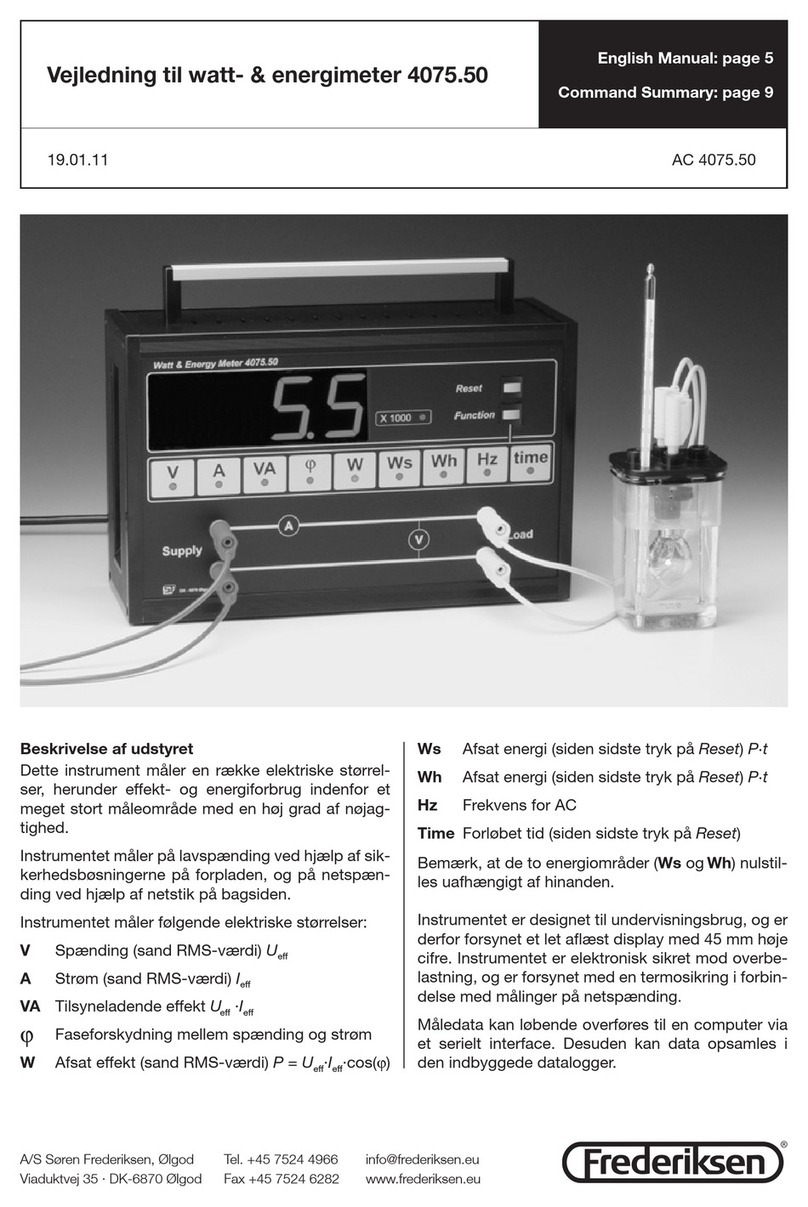In contrast to the other inputs, the pulse inputs are
not identical; in group A, the pulse input is more sen-
sitive than in group B.
(Inputs are further described in Technical Specifica-
tions.)
OPERATION
Start/Stop
Press the Select button repeatedly until the Start/
Stop LED is lit. The setup is now ready.
The device works like a regular or an electronic stop-
watch. The time can be started and stopped manu-
ally (with the Start/Stop button) or with signals fed to
inputs A and B.
The result is reset by pressing the Select key.
Measurements are stored in the internal memory -
see later.
Collision
This function is used with two photocells and two
cars or carts equipped with a ”tab” that can inter-
rupt the light to the photocell. The device times up
to four such interruptions; this will occur in an elastic
collision on an air track, with the carts first moving
towards each other and then away again.
The four speeds are determined from the tab length,
divided by the time of passage.
Press the Select button repeatedly until the Collision
LED is lit. Wait a moment and press Start/Stop.
The setup is now ready.
The first measurement will remain in the display until
all data is recorded. When the photocells have been
interrupted four times, the first time of passage from
input A is shown. The other times are called up by
pressing Memory/Continuous. Times are marked A1,
A2, b1 and b2 in the display.
If all four passages are not occurring, the series can
be interrupted by pressing the Start/Stop button.
The result is reset by pressing the Select key – wait
a moment, then press Start/Stop. Now the device is
ready for a new collision experiment.
Acceleration
This function is used with two photocells a car or
cart equipped with a ”tab” that can interrupt the light
to the photocell. The device times two such interrup-
tions. Furthermore the time interval between switch-
ing off photocell A resp. photocell B is measured.
The velocities of the cart at two photocells are deter-
mined as the plume length, divided by the passage
time. The average acceleration is determined as the
difference between the two speeds, divided by the
time between the two speed measurements.
Press the Select button repeatedly until the Acce-
leration LED is lit. Wait a moment and press Start/
Stop.
The setup is now ready.
The first test result will remain in the display until all
data is recorded. Once photocell A and then B has
been interrupted, the first passage time of input A is
shown. The other times called up by pressing Me-
mory/Continuous. The times are marked A1, b1 and
Ab.
The measuring series can be interrupted by pressing
the Start/Stop button.
The result is reset by pressing the Select key – wait
a moment, then press Start/Stop. Now the device is
ready for a new acceleration experiment.
Period
This function is used for instance with a photocell
and an object that moves periodically and interrupts
the light in the photo cell. Electrical signals or audio
signals via a microphone can also be measured. Use
input A.
The device can operate in two different modes that
are best explained by a few examples:
With rotating objects you can fit a small ”tab” that in-
terrupts the photocell once per. revolution. The mea-
surement shows directly the period of rotation. This
situation corresponds to mode ”A”.
For pendulums, the amplitude is often so large that
the pendulum swings completely through the pho-
tocell beam twice per period of oscillation. In order
to be able to directly read off the period it is required
that the timer skips every other passage of the pho-
tocell. This situation corresponds to the mode ”B”.
The counter is usually in mode ”A”. To put the unit
into mode ”B”, keep the Select button pressed while
switching on with the On/Off switch. The mode re-
mains unchanged until you switch off again.
In state ”A”, measurements lasts for two oscillations
– the result shown is the average.
In state ”B” – for inscrutable reasons – results are
shown for every third pulse – but the figure corre-
sponds as described to the time between every se-
cond pulse.




























